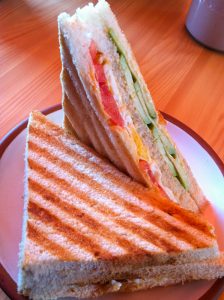White Bread and Hand-Made Rolls: Two Traditions, One Modernity

Do you remember white bread? You know, the Wonderbread concoction. It came in loafs and outside of a thin crust, was just white fluff. I made good pellets to shoot at other kids across the classroom, for sure. And, it was the container of requirement for all kinds of sandwiches as well as the basis for toast.
Though you still see that industrial white bread in Supermarkets across the north, my read is that it is disappearing as artisan bread resurges. Supermarkets now boast their own, in house artisan bakeries and small bakeries are found everywhere.
Now, you are more likely to eat a baguette, a sourdough French boule, a multigrain handformed loaf, or some such, crusty and tasty. Whop knew there was so much flavor that could be where the white fluff was in white bread? Even its whole wheat version had almost no flavor.
As a result, it is a bit of a shock to go into fine Peruvian cafes to get a sandwich and find your breads limited mostly to white bread of the industrial sort. Peru never lost its artisanal bread makers, such as we did in the north. They are still here and, in fact, the bread most commonly consumed for breakfasts and day in and day out delights in homes is one form or another of industrial rolls.
Whether pan huaro, round and thin, with an inner cavity like a kind of Arabic bread is the most common. But you can also find French style rolls, crunchy crusts, really pillowy interiors, and flavor there. There are many others, including a bread with a tincture of anise to give it even more flavor.

These are made in towns such as Oropesa or Huaro as well as in ovens throughout the city. They are always fresh, each morning.
One characteristic they all have is that they are not made in bread pans, molds that constrain the bread into a more square shape. They are all rounded, some taller than others. They are similar, however, in that they have flavor and depth.
I remember struggling with those pans at home, since when I was young many families made their own bread. But we could never attain the seeming weightlessness of Wonderbread and its peers, nor the flavorlessness that made them so artful it seemed.
When I first started coming to the Andes all the rolls fascinated me. They were so different from the breads of my American youth. When I came home in the late seventies and early eighties I had become converted to all of these breads and was excited to see artisan breads begin to flourish in the US.

As a result, it has always seemed a bit strange to go into cafe after cafe in Cuzco as well as Lima and be offered only sandwiches made with “pan molde”, that industrial white bread i put behind me long ago like a dirty little secret of youth.
If I have to order a sandwich, I grumble. I want it on one of the local breads that are so tasty. More often than not I am simply told “we do not work with those breads”.
Of course I can see a possible explanation. The artisan breads are the ordinary one, those that are used in every household and found in every neighborhood market as well as on many street corners each morning. So, what could be special about them to justify claiming to do something different to your clientele? How could you tell them you were giving them something of value?
Furthermore, the specialness of the white bread comes form its association with modernity. It is found in supermarkets and made industrially. It has great shelf life and can be managed easily. It does not depend so much on finicky living organisms, such as yeast and master bakers. Every loaf is always the same.
Ya, ya, ya. Been there, done that.
I get that Peru is proud to be part of a free trade agreement with the US and to be hell-bent on development. It wants to be just as modern as any other, even if in the process it shows itself as backwards by embracing this white junk bread instead of its local artisan breads, despite the great efforts of its master chefs and festivals such as Mistura to celebrate the Peruvian art of artisanal bread making. By being backwards, it is being up and coming instead of jaded like so many of us in the north who celebrate hand work and local weed pulling.
I suspect though there is more. Peru’s system of food is stratified, like layers of geological rock and grit deposited in time. Almost all of what is meant by the word sandwich comes from great Britain, the home of molded breads and industry. It came to Peru with British mercantilism and the spread of beer, soccer, and railroads.
As a result, by using that white bread, Peruvian cafes are honoring the origins of the sandwich.
Even though people like Gaston Acurio are trying to update the Peruvian sanguche as they try to call sandwiches, and use artisanal rolls to set off their meats and sauces, still there is a conservatism here that insists on molded white bread, square as the ideal, modern city block.
Though I may not like white bread, it is here and has been ever since I can remember, in cafe after cafe. I may not like the taste and may much prefer pan huaro. But I guess I will just have to make my own sandwiches or go to the Cusco sandwich shop that emulates Acurio, the Paulina Sanguchería Peruana on Espaderso Street. Things are what they are, after all, and they have meaning.




